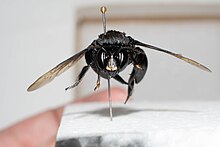| Eulaema cingulata | |
|---|---|

| |
| A pinned specimen facing the camera demonstrating the white markings on the face | |
|
Scientific classification
| |
| Domain: | Eukaryota |
| Kingdom: | Animalia |
| Phylum: | Arthropoda |
| Class: | Insecta |
| Order: | Hymenoptera |
| Family: | Apidae |
| Genus: | Eulaema |
| Species: | E. cingulata
|
| Binomial name | |
| Eulaema cingulata | |
Eulaema cingulata is a large-bodied black and orange corbiculate bee in the genus Eulaema. It is characterized by its size and flashy orange segments of its metastoma. Unlike other Eulaema, E. cingulata has white markings on its face. Specifically, T1 andT3 are black while T2 and T4 through T7 are cream or slightly orange in color. [2] These bees are easily mistaken for bumblebees (Bombus spp.). However, they are actually members of the Euglossini, or orchid bees.
Distribution

E. cingulata can be found in the neotropics, extending its range from Mexico to Brazil. [3] They can occur at elevations as high as 2500 m [4] and persist in anthropogenically disturbed habitats. [5]
References
- ^ "Eulaema cingulata (Fabricius, 1804)". www.gbif.org. Retrieved 26 July 2023.
- ^ Hombergh, Heleen van den. (1999). Guerreros del Golfo Dulce : industria forestal y conflicto en la Península de Osa, Costa Rica /. San José, Costa Rica: Departamento Ecuménico de Investigaciones. doi: 10.5962/bhl.title.124155.
- ^ Andrade, Tamires de Oliveira; Ramos, Kelli dos Santos; López-Uribe, Margarita M.; Branstetter, Michael G.; Brandão, Carlos Roberto F. (2022-12-20). "Integrative approach resolves the taxonomy of Eulaema cingulata (Hymenoptera, Apidae), an important pollinator in the Neotropics". Journal of Hymenoptera Research. 94: 247–269. doi: 10.3897/jhr.94.91001. ISSN 1314-2607. S2CID 254970714.
- ^ McCravy, Kenneth W.; Dyke, Joseph Van; Creedy, Thomas J.; Roubik, David W. (December 2016). "Orchid Bees (Hymenoptera: Apidae: Euglossini) of Cusuco National Park, State of Cortés, Honduras". Florida Entomologist. 99 (4): 765–768. doi: 10.1653/024.099.0431. ISSN 0015-4040. S2CID 53509459.
- ^ O’Neill, Kevin M.; O’Neill, Ruth P.; Delphia, Casey M.; Burkle, Laura A.; Runyon, Justin B. (2023-02-20). "Diversity and distribution of orchid bees (Hymenoptera: Apidae, Euglossini) in Belize". PeerJ. 11: e14928. doi: 10.7717/peerj.14928. ISSN 2167-8359. PMC 9948752. PMID 36846459.
| Eulaema cingulata | |
|---|---|

| |
| A pinned specimen facing the camera demonstrating the white markings on the face | |
|
Scientific classification
| |
| Domain: | Eukaryota |
| Kingdom: | Animalia |
| Phylum: | Arthropoda |
| Class: | Insecta |
| Order: | Hymenoptera |
| Family: | Apidae |
| Genus: | Eulaema |
| Species: | E. cingulata
|
| Binomial name | |
| Eulaema cingulata | |
Eulaema cingulata is a large-bodied black and orange corbiculate bee in the genus Eulaema. It is characterized by its size and flashy orange segments of its metastoma. Unlike other Eulaema, E. cingulata has white markings on its face. Specifically, T1 andT3 are black while T2 and T4 through T7 are cream or slightly orange in color. [2] These bees are easily mistaken for bumblebees (Bombus spp.). However, they are actually members of the Euglossini, or orchid bees.
Distribution

E. cingulata can be found in the neotropics, extending its range from Mexico to Brazil. [3] They can occur at elevations as high as 2500 m [4] and persist in anthropogenically disturbed habitats. [5]
References
- ^ "Eulaema cingulata (Fabricius, 1804)". www.gbif.org. Retrieved 26 July 2023.
- ^ Hombergh, Heleen van den. (1999). Guerreros del Golfo Dulce : industria forestal y conflicto en la Península de Osa, Costa Rica /. San José, Costa Rica: Departamento Ecuménico de Investigaciones. doi: 10.5962/bhl.title.124155.
- ^ Andrade, Tamires de Oliveira; Ramos, Kelli dos Santos; López-Uribe, Margarita M.; Branstetter, Michael G.; Brandão, Carlos Roberto F. (2022-12-20). "Integrative approach resolves the taxonomy of Eulaema cingulata (Hymenoptera, Apidae), an important pollinator in the Neotropics". Journal of Hymenoptera Research. 94: 247–269. doi: 10.3897/jhr.94.91001. ISSN 1314-2607. S2CID 254970714.
- ^ McCravy, Kenneth W.; Dyke, Joseph Van; Creedy, Thomas J.; Roubik, David W. (December 2016). "Orchid Bees (Hymenoptera: Apidae: Euglossini) of Cusuco National Park, State of Cortés, Honduras". Florida Entomologist. 99 (4): 765–768. doi: 10.1653/024.099.0431. ISSN 0015-4040. S2CID 53509459.
- ^ O’Neill, Kevin M.; O’Neill, Ruth P.; Delphia, Casey M.; Burkle, Laura A.; Runyon, Justin B. (2023-02-20). "Diversity and distribution of orchid bees (Hymenoptera: Apidae, Euglossini) in Belize". PeerJ. 11: e14928. doi: 10.7717/peerj.14928. ISSN 2167-8359. PMC 9948752. PMID 36846459.